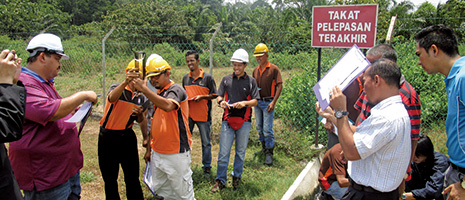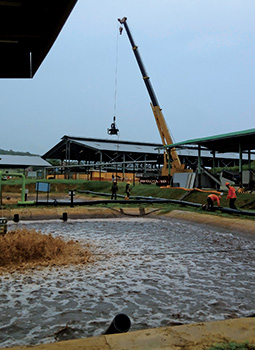Home > Highlighting JAPAN > Highlighting Japan December 2017 > SMEs Overseas
Highlighting JAPAN


The Treatment of Palm Oil Mill Wastewater
Wastewater treatment equipment developed by a small and medium-sized enterprise in Osaka, Japan is now being put to good use at a palm oil mill in Malaysia.
In periods of rapid economic growth, wastewater produced by factories can lead to pollution of water resources. Japan experienced serious water pollution during the period of rapid economic growth beginning in the 1950s and solved the problem in the 1980s through technological development and the introduction of environmental regulations.
There is an important process in wastewater treatment called aeration, which entails sending air into a wastewater treatment reservoir, or reaction tank, and activating microorganisms. Treatment methods include creating foam on the surface of the water using revolving wings and brushes, and creating bubbles by sending air into plates and pipes with small holes set at the bottom of the treatment reservoir by fan. However, both of these methods are defective in that it is difficult to stir all the water in the treatment reservoir, which makes it impossible for air to circulate the reservoir. Other problems include the noise made by the wings and brushes, the scattering of wastewater, and the clogging of plates and pipes with sludge.
In 1975, Hanshin Engineering Co., Ltd. in Osaka City (founded in 1950) developed the Aquarator® to solve these problems. The Aquarator is placed on the bottom of the treatment reservoir, absorbs wastewater from the bottom and emits tiny bubbles created by a fan in every direction of the reservoir from six apertures on top. In this way the treatment reservoir is stirred and aerated equally, and the wastewater is purified efficiently.
About 10,000 Aquarators have been sold to date, and they have been introduced to about 1,000 domestic drainage facilities, which is about half of such facilities nationwide.
Hirotaka Kawashima, who belongs to the Overseas Sales Division of Hanshin Engineering Co., says, “Aquarators enable electricity cost savings, and are also advantageous in that they have a simple structure making them very easy to maintain.”
Hanshin Engineering Co. also operates in Asian countries with a focus on palm oil mills in Malaysia. Palm oil is a key industry in Malaysia, being used to produce margarine, soaps and cosmetics among other things. In recent years, however, environmental problems associated with palm oil mill wastewater have come to the fore. The Malaysian government is strengthening compliance with the standards for the treatment of palm oil mill wastewater, but there are many mills whose wastewater emissions significantly exceed the standards. In this situation, the Malaysian Palm Oil Board (MPOB), which administers the palm oil industry within the Ministry of Plantation Industries and Commodities, is paying attention to Aquarators.
Kawashima says, “An MPOB researcher who listened to my presentation at a technical exchange meeting held in Osaka in 2012 told me that he wanted to use Aquarators. In response to this request, we formulated project plans in cooperation with the Osaka prefectural government and other private companies in Osaka.”
In 2014, the project was temporarily adopted as part of the Japan International Cooperation Agency (JICA)’s Verification Survey of Support for Japanese Small and Medium Enterprises (SMEs) Overseas Business Development, and was launched on a full scale at a mill in Pahang in northern Malaysia in March 2016. Three Aquarators and two pieces of screening equipment for removing the residue contained in wastewater were introduced to the mill. In addition, so as to discuss the use of carbonized sludge for fuel of the mill boilers, one piece of equipment for carbonizing sludge was also installed. Hanshin Engineering Co. dispatched instructors from Japan to nurture local human resources and held two study sessions for the engineers of the MPOB and palm oil-related companies.
As a result of the project, the BOD values1 of the mill wastewater improved significantly.2 The project was completed in July this year, but Aquarators will be introduced to other palm oil mills next year.
Kawashima says, “MPOB researchers rated our project highly and proposed that we jointly release research papers. We will disseminate Aquarators in Southeast Asia, especially in Malaysia, and contribute to environmental improvement in multiple countries.”
Japanese environmental technologies like that of Hanshin Engineering Co. are expected to play a major role in Southeast Asia in the years ahead, as the region continues to experience rapid economic growth.

Note
1 BOD stands for Biochemical Oxygen Demand and is one indicator of water quality.
2 For the wastewater treatment standards set by the Malaysian government (at the point of final discharge), the standard value of 100 mg/l improved to the lowest value of 20 mg/l.
© 2009 Cabinet Office, Government of Japan







